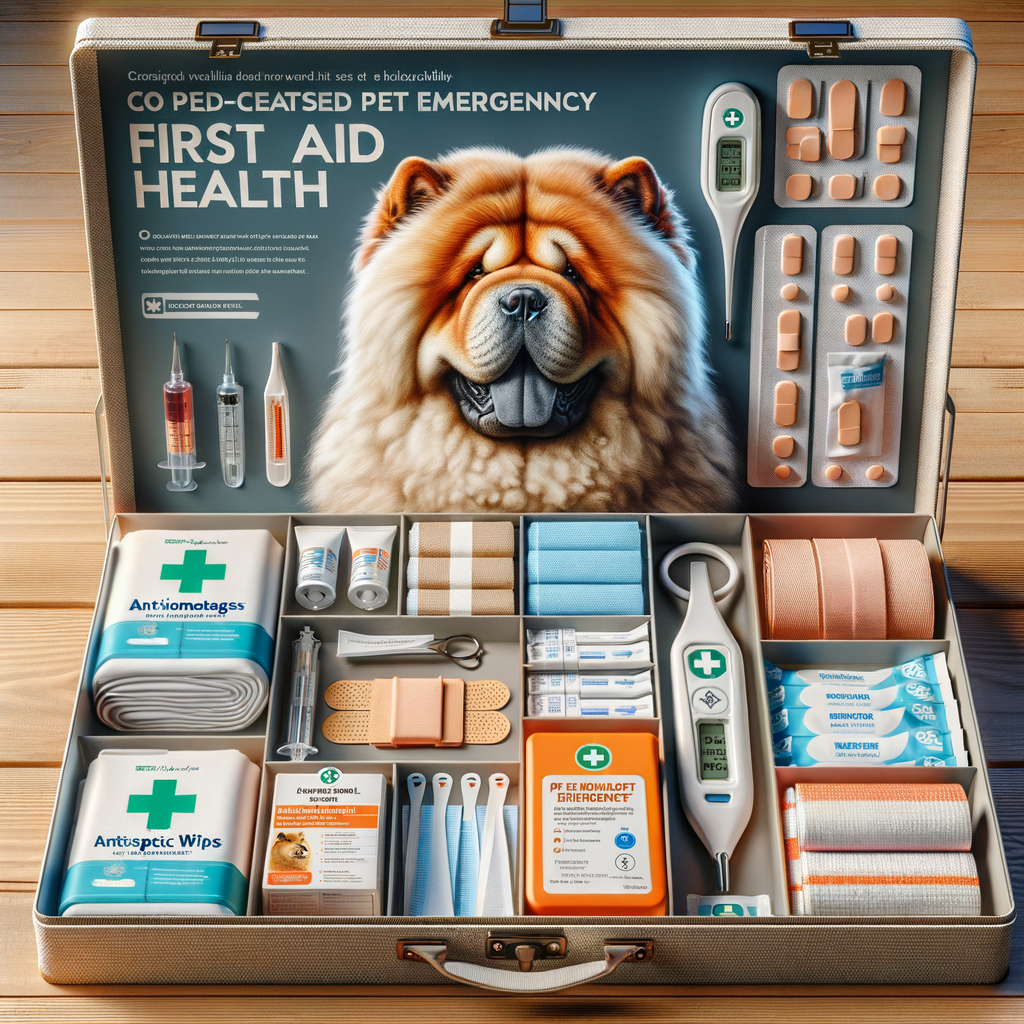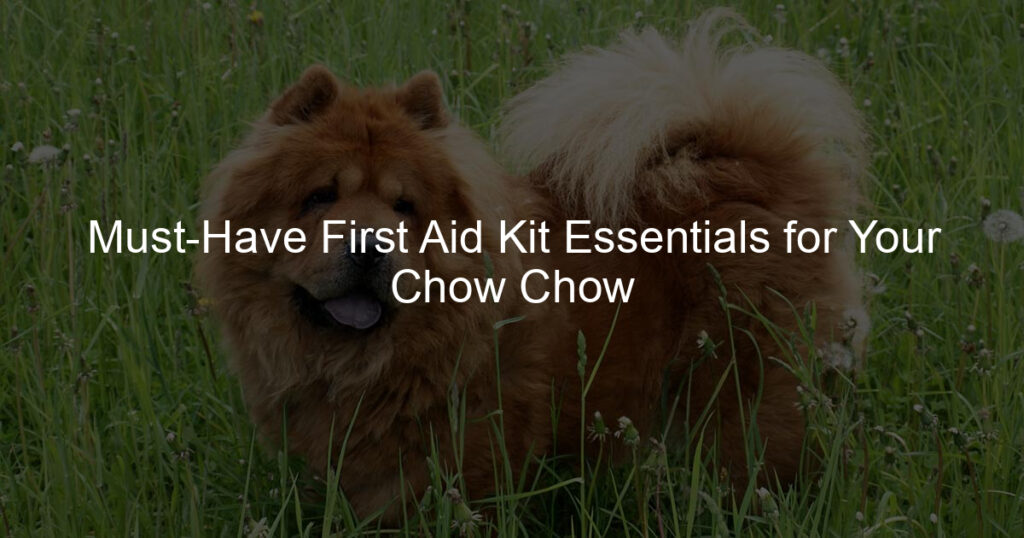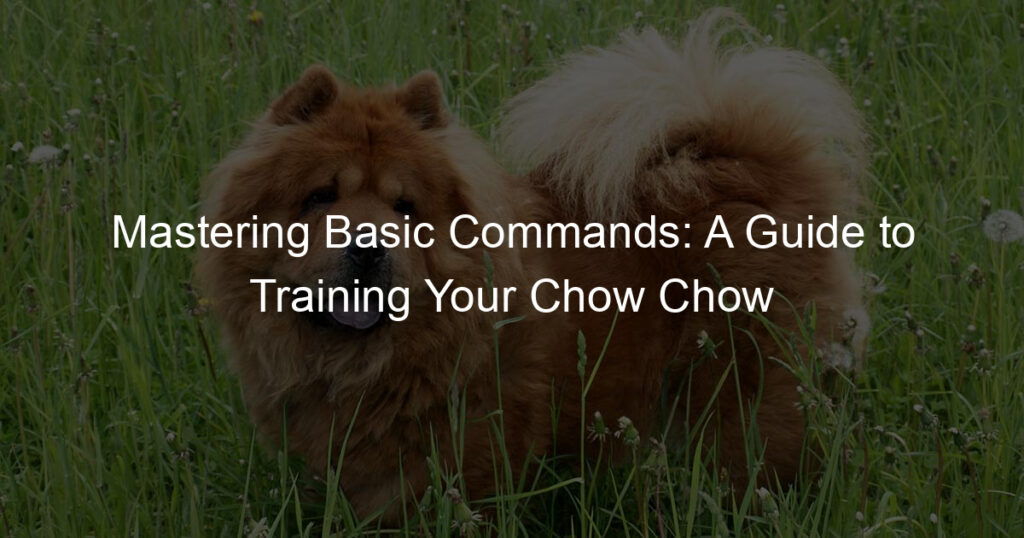
Introduction to Chow Chow Health Care
Chow Chows are a unique breed of dogs with their fluffy coats and lion-like appearance. They are known for their loyalty and protective nature. However, like any other breed, they also have specific health needs that must be addressed to ensure they live a long and healthy life. In this blog post, we will delve into the world of Chow Chow health care, focusing on the importance of a first aid kit and common health issues that Chow Chows may face.
Just like humans, dogs can also encounter unexpected accidents or health issues. Having a first aid kit for your Chow Chow is essential. It can be a lifesaver in emergency situations, providing immediate relief to your furry friend before you can get them to a vet. A first aid kit should include items like bandages, antiseptic wipes, a digital thermometer, and a pet first aid book. Remember, a first aid kit is not a replacement for veterinary care, but it can help manage a situation until professional help is available.
Chow Chows, like any breed, are prone to certain health issues. Some of the common health problems include hip dysplasia, entropion (a condition where the eyelid folds inward), and skin issues. They are also known to have a higher risk of developing certain types of cancers. Regular check-ups with your vet can help detect these issues early and provide appropriate treatment. It is also important to maintain a healthy diet and regular exercise for your Chow Chow to prevent obesity, which can lead to other health problems.
Understanding your Chow Chow’s health needs is the first step towards providing them with a happy and healthy life. In the following sections, we will discuss more about essential items for Chow Chow health, provide case studies on first aid for Chow Chows, and guide you on building your pet emergency kit. Stay tuned to ensure your Chow Chow’s health and well-being.
Essential Items for Chow Chow Health
When it comes to maintaining the health of your Chow Chow, there are certain items that are absolutely essential. These items can help you manage minor health issues at home and even save your dog’s life in an emergency. Let’s take a closer look at these items.
Dog First Aid Kit Essentials
Just like humans, dogs can also get injured or sick. Having a first aid kit for your Chow Chow can be a lifesaver in such situations. Here are some of the essential items you should have in your dog’s first aid kit:
- Bandages and gauze for wound care: These are useful for covering wounds and preventing infection. They can also be used to apply pressure to a bleeding wound.
- Hydrogen peroxide to induce vomiting in case of poisoning: If your Chow Chow ingests something toxic, hydrogen peroxide can be used to induce vomiting. However, it’s important to consult with a vet before doing this.
- Thermometer to check for fever: Dogs can also get fevers, just like humans. Having a thermometer on hand can help you monitor your dog’s temperature and identify if they’re unwell.
- Tick removal tool: Ticks can cause serious health issues in dogs. Having a tick removal tool can help you safely remove ticks from your Chow Chow’s skin.
Remember, these items are just the basics. Depending on your dog’s specific needs, you may need to add more items to your first aid kit. Always consult with your vet to ensure you have everything you need to keep your Chow Chow healthy and safe.
Additional Items for Chow Chow Breed
While the general first aid kit essentials are important for all dogs, there are a few additional items that are particularly useful for the Chow Chow breed. These items are designed to help maintain the health and hygiene of your Chow Chow, and they can be easily added to your pet’s first aid kit.
- Eye wash solution for eye care: Chow Chows are known for their deep-set eyes, which can be prone to irritation and infections. An eye wash solution can help to clean and soothe your pet’s eyes, removing any dust or debris that may have gotten into them. This can help to prevent eye infections and keep your pet’s eyes healthy.
- Ear cleaning solution for ear care: Chow Chows have thick, fluffy ears that can trap dirt and moisture, leading to ear infections. An ear cleaning solution can help to keep your pet’s ears clean and dry, preventing infections and promoting overall ear health.
- Brush for grooming and checking for ticks: Chow Chows have a thick double coat that requires regular grooming. A good quality brush can help to remove loose hair and prevent matting. Additionally, regular grooming is a great opportunity to check for ticks and other parasites that may have latched onto your pet’s skin.
These additional items are not just optional extras, but essential tools in maintaining the health and wellbeing of your Chow Chow. By including them in your pet’s first aid kit, you can ensure that you are prepared for any health issues that may arise.
First Aid for Chow Chows: Case Studies
Let’s explore some real-life scenarios to better understand how to handle emergencies with your Chow Chow. These case studies will provide practical insights into dealing with minor wounds, tick infestations, and poisoning incidents.
-
- Case study 1: Dealing with a minor wound
Meet Max, a playful Chow Chow who accidentally got a minor cut while playing in the backyard. His owner, Lisa, immediately cleaned the wound with warm water and mild soap. She then applied a pet-friendly antiseptic and covered the wound with a bandage. Lisa monitored the wound daily to ensure it was healing properly and there was no sign of infection. In a week, Max was back to his playful self, thanks to Lisa’s prompt first aid response.
-
- Case study 2: Handling a tick infestation
Next, we have Bella, a Chow Chow who loves exploring the outdoors. During one of her adventures, she picked up a tick infestation. Bella’s owner, John, noticed Bella scratching excessively and upon closer inspection, found ticks on her fur. John used a pair of tweezers to carefully remove the ticks, making sure not to leave any parts behind. He then cleaned the affected areas with a pet-safe tick treatment. John also treated his backyard to prevent future infestations and now regularly checks Bella for ticks after her outdoor adventures.
-
- Case study 3: Responding to a poisoning incident
Lastly, we have Rocky, a curious Chow Chow who ingested a poisonous plant during a walk in the park. His owner, Sarah, noticed Rocky acting lethargic and drooling excessively. She quickly realized he had eaten something harmful. Sarah immediately called her vet and was advised to induce vomiting using a small amount of hydrogen peroxide. After Rocky vomited, Sarah rushed him to the vet for further treatment. Rocky made a full recovery, and Sarah now keeps a closer eye on him during their walks.
These case studies highlight the importance of being prepared for emergencies. Having a basic understanding of first aid can make a significant difference in your Chow Chow’s health and wellbeing. Remember, when in doubt, always consult with a professional veterinarian.
Building Your Pet Emergency Kit
When it comes to the health and safety of your beloved Chow Chow, being prepared is key. One of the best ways to ensure you’re ready for any situation is by building a pet emergency kit. This kit will contain all the essential items your pet might need in case of an emergency. But before we dive into what goes into the kit, let’s talk about the container itself.
Choosing the Right Container
The container you choose to hold your pet emergency kit is just as important as the items inside. It needs to be the right size, portable, and durable. Let’s break down these three factors:
- Size considerations: The size of your container should be large enough to hold all the necessary items, but not so large that it becomes cumbersome. A medium-sized plastic container with a secure lid is usually a good choice. Remember, it’s not just about fitting everything in, but also about being able to find what you need quickly in an emergency.
- Portability: In an emergency, you may need to take your pet and your kit and leave quickly. Therefore, your container should be easy to carry. Look for containers with handles or ones that can fit into a backpack. If your pet is large, consider a container with wheels.
- Durability: The container should be sturdy enough to withstand being moved around, dropped, or even being outside in harsh weather conditions. A hard plastic container is usually a good choice for durability. It’s also a good idea to choose a container that’s waterproof, to protect the items inside.
Choosing the right container is the first step in building your pet emergency kit. By considering size, portability, and durability, you’ll ensure that your kit is ready for any situation.
Organizing Your First Aid Items
When building your pet emergency kit, organization is key. Properly arranging your first aid items will not only make your kit more efficient, but it will also ensure you can quickly find what you need in an emergency. Here are some tips to help you organize your first aid items effectively:
-
- Grouping Items by Use
Start by categorizing your items based on their purpose. For instance, bandages, gauze, and adhesive tape can be grouped together as they are all used for wound care. Similarly, items like a thermometer, stethoscope, and tweezers can be grouped together as they are used for health checks and minor procedures. By grouping items by use, you can quickly locate what you need without rummaging through the entire kit.
-
- Keeping Items Accessible
Ensure the most frequently used items are easily accessible. For example, items like gloves, a digital thermometer, and a first aid manual should be at the top of your kit. Less frequently used items, such as a splint or a snake bite kit, can be stored at the bottom. This way, you won’t waste precious time searching for essential items during an emergency.
-
- Regularly Checking and Restocking Items
Regularly check your first aid kit to ensure all items are in good condition and have not expired. Replace any used or outdated items promptly. It’s a good idea to do this check every six months, or whenever you use the kit. This will ensure your kit is always ready for use when needed.
Remember, the goal of organizing your first aid items is to ensure you can quickly and easily find what you need in an emergency. By grouping items by use, keeping items accessible, and regularly checking and restocking items, you can ensure your pet emergency kit is always ready for use.
| Group | Items |
|---|---|
| Wound Care | Bandages, gauze, adhesive tape |
| Health Checks and Minor Procedures | Thermometer, stethoscope, tweezers |
| Frequently Used Items | Gloves, digital thermometer, first aid manual |
| Less Frequently Used Items | Splint, snake bite kit |
Conclusion: Ensuring Your Chow Chow’s Health
As we wrap up this discussion on Chow Chow health, it’s important to remember that maintaining your pet’s well-being is a continuous process. There are three key aspects to focus on:
- The importance of regular vet check-ups
- The benefits of preventive care
- The role of a well-stocked first aid kit in your Chow Chow’s health
Importance of Regular Vet Check-ups
Regular vet check-ups are crucial for your Chow Chow’s health. These visits allow the vet to detect any potential health issues early, making treatment more effective. According to the American Veterinary Medical Association, pets should have at least one vet visit per year. For Chow Chows, these check-ups often include dental care, eye examinations, and heart health assessments.
Benefits of Preventive Care
Preventive care is another essential aspect of your Chow Chow’s health. This includes regular exercise, a balanced diet, and timely vaccinations. Preventive care can help avoid common health issues like obesity, dental disease, and heart problems. It’s much easier to prevent these conditions than to treat them.
Role of a Well-Stocked First Aid Kit in Your Chow Chow’s Health
Finally, having a well-stocked first aid kit can be a lifesaver for your Chow Chow. This kit should include items like bandages, tweezers, a thermometer, and a list of emergency vet contacts. A good first aid kit can help you handle minor injuries and stabilize your pet until you can reach a vet.
In conclusion, ensuring your Chow Chow’s health requires regular vet check-ups, preventive care, and a well-stocked first aid kit. By focusing on these areas, you can help your pet live a long, healthy, and happy life.














